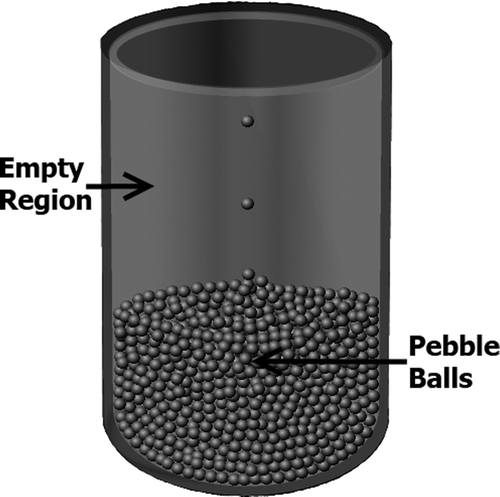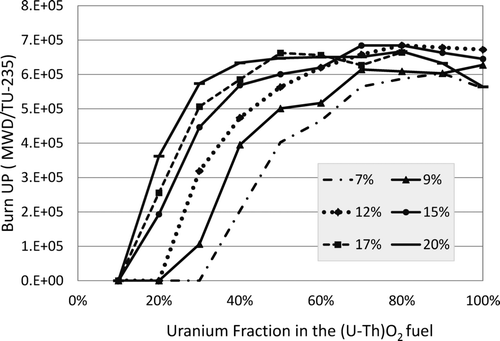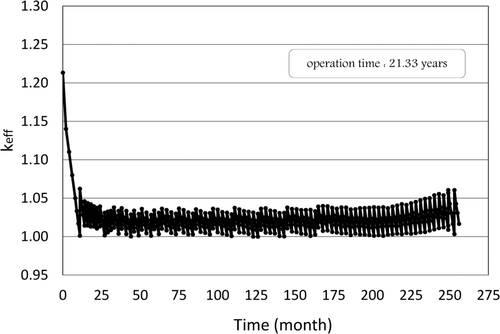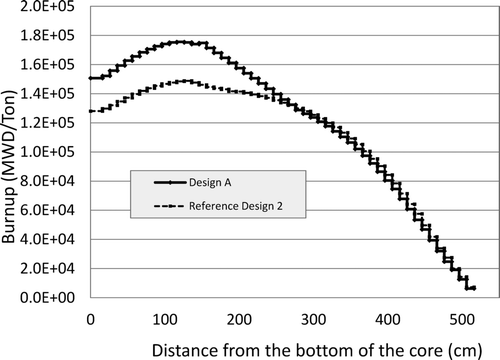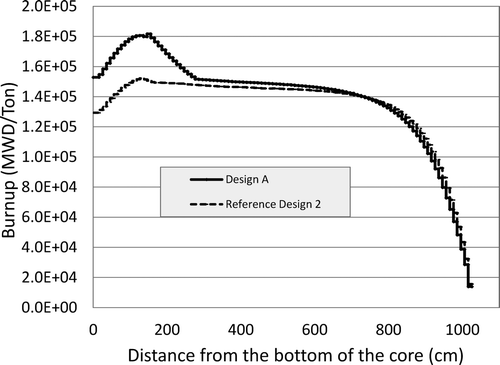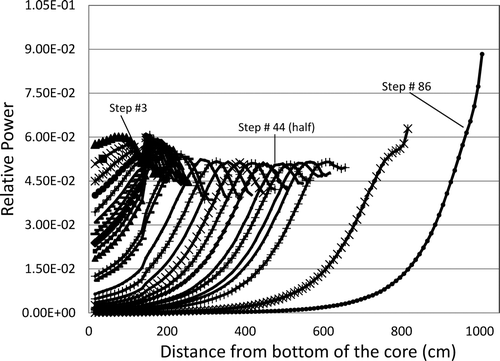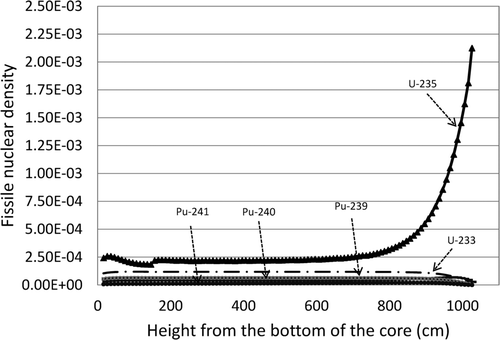Abstract
The limitation of natural uranium resources and the improvement of economic values of nuclear reactors are important issues to be solved in the future development of these reactors. In our previous study, we presented an innovative design for simplifying a pebble bed reactor, and the optimization of this design showed that burnup values could be increased and natural uranium uses could be reduced. The purposes of the current study were to design a simplified pebble bed reactor by removing the unloading device from the reactor system and to further optimize the burnup characteristics of this reactor with a peu à peu fuel-loading scheme by introducing thorium in the fuel configuration as a fertile material. Another goal was to optimize the fuel composition so that the system could achieve even better burnup characteristics and use scarce uranium resources more efficiently. Using a specially developed computer code, we analyzed and optimized the performance of a 110-MWt simplified pebble bed reactor using a peu à peu fuel-loading scheme. An optimized design using 30% of fertile thorium mixed with uranium fuel with 15% 235U enrichment and a 7% packing fraction calculated to achieve a high burnup of 140 GWD/T for more than 21 years' operation time that could save 13 to 33% of natural uranium use compared with the savings noted in our previous study. Neutronic, burnup and fuel economic analysis for this optimized design are discussed in this study.
1. Introduction
To reduce the rate of depletion of natural uranium due to its utilization as nuclear fuel, innovative ways to use nuclear fuels must be developed. Of course, a fast reactor is a good option for efficient natural uranium use, but the slow development of this type of reactor forces us to look at other available options immediately. Looking at thermal nuclear power plants as a proven technology due to their operating history and the research and development that has gone into them, we believe the high temperature gas reactor (HTGR) will be one of the best options, due to its higher efficiency compared with that of water moderated reactors, and the high output temperature of HTGRs can be utilized for other industrial purposes such as hydrogen production as well as for district heating. One type of HTGR, the pebble bed reactor (PBR), has inherent and passive safety features, namely, the coating of fuel particles, which limits the release of radioactive material into the environment, and the use of a large amount of graphite as a moderator and reflector, which gives the core a high heat capacity. These safety features have become a very important issue in avoiding severe nuclear accidents due to active system failure, which has happened in Fukushima. However, the high cost and complexity of pebble bed reactors, especially the unloading machinery, forces us to think about innovations for this reactor design that would be simpler in design and operation and less expensive to construct and operate.
In a previous study [1], we presented the concept and performed burnup and thermal hydraulic analysis of an innovative design for a PBR using uranium fuel that could be operated more simply than previous PBRs by removing the unloading device from the system. The reactor has 110 MWt with low enrichment uranium (LEU) fuel as a conventional case (reference design 1) and 12% uranium enrichment and a 7% coated fuel particles fraction inside the pebble ball as the optimum fuel configuration obtained by parametric survey (reference design 2). The average burnup was 51 GWD/T for the LEU case and could be improved to 135 GWD/T for the optimum case. Optimization of the fuel configuration could decrease natural uranium use by about 23% for the power generated per year during reactor operation.
To improve the burnup characteristics of this reactor design while at the same time using natural uranium more effectively, we also considered the use of thorium. Thorium-based fuel is gaining interest for many researchers in the nuclear industry as an alternative to the existing uranium–plutonium-based fuel. The abundance of thorium resources worldwide, which is several times larger than the uranium resources, could be expected to significantly extend the role of nuclear power as one of the world's energy resources. Many studies have been performed to examine the use of thorium as a nuclear fuel, but additional time and effort are needed to make its use on the industrial scale possible. In some studies about the use of thorium in the HTGR [2–4], they have used combination of 233U and 232Th to improve the burnup performance of the reactor. However, because 233U could not be found naturally, therefore in the meantime, using natural thorium with existing technology, for example, as a fertile material mixed with the existing uranium dioxide fuel (232Th, 238U – 235U)O2, which is going to be performed in this study, is one way to extend the nuclear horizon by reducing the level of natural uranium utilization meanwhile trying to keep or even increase the burnup characteristics of the reactor.
The purposes of this study were to design a simplified PBR by removing the unloading devices from the system and then to optimize the burnup characteristics of this reactor with a peu à peu fuel-loading scheme by introducing thorium into the fuel configuration as a fertile material. We also planned to perform optimization of the thorium fraction in the UO2 fuel, of uranium enrichment and of the packing fraction of coated fuel particles inside the pebble ball, so that the system could achieve better burnup characteristics and use scarce uranium resources more efficiently. We analyzed our design using a specialized computer code that was developed based on the transport method due to the weakness of the neutron diffusion method [1].
2. Calculation method
2.1. Peu à peu fuel-loading scheme
In this study, the PBR design was simplified by removing the unloading device from the system, which means that pebble balls inserted will never be discharged from the reactor core and will remain at the bottom of the core throughout reactor operation. A suitable fuel-loading scheme for this kind of reactor is the peu à peu fuel-loading concept [5], in which pebble balls are inserted little by little from the top of the core so that the fuel inside the core continuously increases, as shown in . This means that the burnup cycle and reactivity are controlled by the addition of fuel. This simplification allows fuel loading to be conducted in a very simple way.
2.2. Calculation procedures
Study of the peu à peu fuel-loading concept was performed previously by Teuchert et al. [5], but they used a diffusion-based calculation method. It is difficult to obtain accurate calculation results using this method, because of the large cavity region above the core, which is bigger than that of conventional PBRs and which is there during most of the reactor's operation period. A large cavity region would make it difficult to determine the diffusion coefficient in the axial direction, making accurate calculation with the diffusion method challenging. This is why in the present study, we are not using a diffusion-based method but instead are employing a transport-based method, i.e. the Monte Carlo method, to obtain more accurate calculation results. To ensure sufficient accuracy, we performed calculations with uncertainty smaller than 0.06% for the effective multiplication factor (k eff).
To calculate and analyze the peu à peu fuel-loading concept in a simplified PBR in an earlier study [1], a computer code was developed using FORTRAN language and based on Monte Carlo MVP [6]/MVP-BURN [7] codes. The code was needed as an analytic tool to efficiently examine the peu à peu fuel-loading scheme, to speed up the calculation process and to avoid any input mistakes due to the numerous steps involved in the calculation procedure. MVP/MVP-BURN was used because of its ability to treat the heterogeneity of the coated fuel particles inside the pebble ball and the heterogeneity of the pebble balls inside the reactor core in the PBR system. In the MVP/MVP-BURN code, the double heterogeneity can be treated by a statistical geometry model. This is a method of neutron transport calculations that could treat randomly distributed spherical fuel elements, coated particles, pebble bed fuels and the like with the continuous energy Monte Carlo method. In this study, the nuclear data library used for the calculation was JENDL-4.0 [8].
In real applications of the peu à peu concept, the fuel elements are inserted continuously into the core, while in this study, for calculation purposes, the fuel elements were inserted in a step-wise procedure. The reactor core was subdivided into several axial fuelling zones. At startup, the lower layers of the core were filled with fuel elements, leading to the first criticality. At various time intervals, one fuel layer after another was added, depending on the requirements of criticality and compensation for the burnup; a burnup calculation was performed for each fuel-loading step.
3. Parametric surveys to determine the optimal fuel configuration
It was important to decide the best fuel composition to be used in the reactor design, and thus we performed parametric surveys to investigate the burnup characteristics of different fuel compositions. The purpose of this parametric survey was to determine the effect of introducing thorium as a fertile material into the mixed uranium dioxide fuel, so that the optimal fuel configuration could be obtained. In this parametric survey, the thorium fraction was varied from 0 to 100% in the mixed uranium dioxide fuel. Uranium enrichment was varied from 1 to 20%, and several packing fractions (5 to 9%) of coated fuel particles inside the pebble balls were also taken into account. These combinations revealed a set of expected maximum burnup characteristics.
Calculations were performed by the Monte Carlo method using the MVP/MVP-BURN code. Specific regions containing specific fuel configurations, as shown in Table 1, were defined, and calculations were carried out in the infinite geometry to find the burnup characteristics of the system of interest. In this parametric survey, burnup, energy per ball and fissile and fertile materials used in the core including the consumed mass of fissile materials and critical periods were analyzed for each combination of the fuel configuration.
shows results obtained by the parametric survey that described the burnup values for each fuel composition's thorium fraction in the mixed uranium dioxide at different levels of uranium enrichment with a specific packing fraction (7%) of coated fuel particles inside the pebble balls, when the reactivity reached unity by the burnup. The packing fraction of 7% was selected due to its superiority among the other values for the packing fraction of coated fuel particle inside the pebble ball utilized in this study. It was confirmed from the parametric surveys that this configuration was 6% higher on average compared with the highest values obtained from the others packing fractions examined in this study. In addition to that, superiority of 7% of packing fraction for coated fuel particle inside the pebble ball for the parametric surveys of fuel configuration was also confirmed and described in the previous study [1].
From parametric surveys, as seen in , the three most optimal burnup values could be obtained if the inserted fuel had following compositions:
| 1. | 30% of fertile thorium; 70% of uranium with 15% enrichment of 235U; and 7% of packing fraction. | ||||
| 2. | 20% of fertile thorium; 80% of uranium with 12% enrichment of 235U; and 7% of packing fraction. | ||||
| 3. | 10% of fertile thorium; 90% of uranium with 12% enrichment of 235U; and 7% of packing fraction. | ||||
Using these fuel configurations as supply fuel for a peu à peu fuel-loading scheme in the simplified PBR, one could expect to achieve the highest possible burnup distribution and lower the use of natural uranium during reactor operation.
4. Optimization of thorium-based fuel in a small simplified PBR with a Peu à peu fuel-loading scheme
4.1. Neutronic and burnup characteristics
Using the optimized fuel configurations obtained by the parametric survey described in Section 3, we calculated three simplified PBR designs with the peu à peu fuel-loading scheme which have possibility to achieve optimum burnup characteristics and the use of efficient natural uranium. The specifications of these reactors were the same with the one described in a previous study [1] as we were going to compare the obtained results in term of burnup characteristics especially the use of natural uranium during reactor operation. The detailed specifications of the pebble ball are the same as those listed in the parametric survey, as shown in Table 1, and the specifications of the reactor are shown in Table 2. These reactors have 110 MWt of power with a radius of 200 cm and a height of 1050 cm and could fit inside a reactor pressure vessel (RPV) of the High Temperature engineering Test Reactor (HTTR) design [9]. The RPV of the HTTR was adopted because of the practicality and ease of building a reactor based on well-proven technology such as that of the HTTR. At the beginning of reactor operation, the core height was 146 cm, and at the end of the operation, the height was 1026 cm with the remaining 24 cm being a cavity.
Using the calculation procedures developed in our previous study, we analyzed the multiplication factor during reactor operation, burnup distribution at the beginning, middle, and end of reactor operation, the proportions of the important nuclear isotopes and the fuel economics. For the operation time, design A with the fuel configuration of 15% uranium enrichment, 7% packing fraction, and 30% fertile thorium in the mixture of uranium fuel has 21.3 years of operation time, Design B with the fuel configuration of 12% uranium enrichment, 7% packing fraction, and 20% fertile thorium in the mixture of uranium fuel has 19.3 years of operation time, and Design C with the fuel configuration of 12% uranium enrichment, 7% packing fraction, and 10% fertile thorium in the mixture of uranium fuel has 22.3 years of operation time.
shows the effective multiplication factor against the operation time of the reactor for Design A, which has a similar k eff profile to that of the other two designs.
shows that excess reactivity at the beginning of reactor operation is quite high (17.6%). This is because the enrichment in this design was high (15%), so that at the first layer (first criticality) the number of fission reactions is high and the critical time is also high. In real applications, this excess reactivity could be reduced using control rods and burnable poison. This is necessary only at the beginning of reactor operation, because after the first fuel layer, pebble balls are added little by little and the excess reactivity is small, so no additional control system/tools are needed. The reactivity is controlled by the addition of the balls during reactor operation.
In this calculation, there are also spikes in the k eff (3.6% on average) during reactor operation; this is because, for calculation purposes, we used a stepwise procedure, dividing the reactor core into 89 regions axially. In actual operation, pebble balls will be added little by little so that no significant spikes will occur.
The burnup analysis was performed for each design, but because the burnup characteristics for each of these three reactor designs are similar, we show only the burnup characteristics of design A.
Comparison with Reference Design 2, which is the optimal design for uranium cases calculated in the previous study [1], was performed to show the effect of introducing thorium into fuel composition. At the beginning of reactor operation, burnup values at the top of the core were smaller than those at the bottom of the core, with the average and maximum burnup of 5 GWD/T and 7 GWD/T, respectively.
The burnup distribution profile reflects the presence of a large cavity region at the top of the core where a lot of neutron leakage occurs; meanwhile, at the bottom of the core there is a reflector region at which neutron leakage is smaller, implying that the burnup values at the bottom layer are higher compared to those at the top layers. shows this profile, in comparison with the Reference Design 2. As shown in , the burnup profile at the beginning of reactor operation for fuel with thorium (Design A) was higher (about 49% on average) compared with fuel using only uranium (Reference Design 2).
In the middle of reactor life, neutron leakage at the bottom of the core is relatively high, but after the first layer, the gradual addition of new pebble balls reduces neutron leakage. Thus, near the boundary between the first and the subsequent layers the maximum burnup occurs, because neutron leakage is small in this region. However, neutron leakage is high at the top of the reactor core because of the cavity region that impinges on the burnup value. The maximum burnup value was 176 GWD/T, and the average was 121 GWD/T, as shown in , in comparison with the reference design case. On average, Design A with the addition of thorium has burnup values 8% higher than those of Reference Design 2, which uses only uranium as fuel.
Characteristics similar to those at the middle of reactor life are in effect at the end of reactor life. The burnup distribution is shown in , in comparison with the reference design case. It can be seen from that at the middle of the core (300–800 cm) the burnup is relatively stable, because fission reactions are relatively stably maintained in this region. This is because only slight neutron leakage occurs in this region. However, at the top of the core, a lot of neutron leakage still occurs, which tends to decrease the burnup. The maximum burnup value at the end of reactor life is 182 GWD/T, and the average value is 140 GWD/T. This burnup value was higher compared with the burnup value obtained in the previous studies, for example, for the Germany THTR-300 pebble bed reactor with 300 MWe using uranium and 232Th fuel which has burnup value approximately 110 GWD/T [2]. In addition to that, compared with other related studies about the use of thorium in the HTGR, such as a block type Fort St. Vrain reactor with 330 MWe power which has 100 GWD/T burnup value [3] and a 30 MWt block type HTGR with a transitional fuel composition using (235U, 232Th)O2 with burnup value as 120 GDW/T [4], this simplified pebble bed reactor with the optimized thorium fuel configuration has higher burnup value. However, compared with the reference design case [1], burnup values of this Design A with thorium were 4.5% higher than those of Reference Design 2 using only uranium. The changes of the burnup at the end of reactor operation are strongly affected by the power distribution for each step of the peu à peu fuel loading scheme which was changing during reactor operation as shown in Figure 7. At the first fuel loading steps, power profile was changing rapidly and each time it became smaller, especially at the bottom layers of the core due to neutron leakage. Then, power increased due to insertion of new fuel, and as a result the peak of the burnup appeared around 185 cm which was a few layers above the first fuel layer. After several fuel loading steps, power profile became similar and the core achieved ‘equilibrium' condition resulting in a quite stable burnup distribution at the middle of the core. In the last steps of the fuel loading, power profile became very high at the top of the core due to the new fuel that is loaded from the top of the core.
Regarding the power distribution profile of this reactor with thorium fuel, it has essentially the same profile as the reactor with uranium fuel as described in the previous study [1]. Therefore, the steady state thermal hydraulic characteristics of these designs are also similar and fulfill the thermal hydraulic requirement described in the previous study.
The density of fissile isotopes at the end of reactor operation for Design A is shown in . From the figure, it is clear that the fissile density of 235U at the bottom of the core is much smaller than that near the top of the core, since fresh fuel is always inserted from the top of the reactor core. As the figure shows, the density of 235U at the end of the first region (146 cm) is very small because this region has been burning for a longer time compared to the upper regions. That is why the nuclide density of 235U is higher near the top of the reactor core. From this figure, we can also see that fissile 233U was formed during reactor operation. Fissile 233U is formed by the neutron capture of fertile 232Th added as a mixture in the fuel. As we can see from , the fraction of 233U is higher compared with fissile plutonium isotope densities, such as 239Pu, 240Pu, and 241Pu, which means that the addition of thorium has more significant effects on the burnup of the reactor than those of plutonium. The fissile isotope densities of 239Pu, 240Pu, and 241Pu are smaller at the top layer. The fuel at the top one-fifth of the core potentially could be re-used as nuclear fuel due to the high fissile density contained in the pebble balls in this region.
The analysis reveals that the optimization of the fuel configuration (results of parametric surveys) using the peu à peu concept in a PBR design could achieve better burnup performance and more efficient use of scarce uranium resources than the uranium fuel design.
4.2. Fuel economy
From the point of view of fuel economy, designs A, B, and C require 20.4, 23.7, and 26 tons of fissile material during their lifetimes, respectively. By taking the number of tail assays as 0.25%, one could derive the total separate work units (SWU) as 606.8, 544.4, and 616.9 kSWU, respectively. Thus, we can estimate that the total natural uranium for the three designs are 629.6, 581.3, and 658.3 tons, respectively. By considering the energy produced and the total operation time for each design, one could also determine that the mass of natural uranium needed per MWe produced per year for designs A, B, and C is 0.58, 0.60, and 0.59 tons, respectively. Thus, as shown in Table 3, from the fuel economy point of view, it is clear that the optimal design is design A which could reduce the amount of natural uranium needed by 33.3% compared with reference design 1 and by 13.4% compared with reference design 2.
4.3. Calculation uncertainty
In this study of the peu à peu fuel-loading scheme in a small simplified PBR, there are three main possible factors which will affect the uncertainty of the calculation:
4.3.1. Uncertainty due to statistical error of the atomic nuclear density calculation
In order to investigate the statistical uncertainty and judge the reliability of calculated results obtained by MVP-BURN, different calculations using MVP-BURN with different number of neutron histories and different random numbers for the same fuel configuration of the simplified PBR system use in this study have been performed. Then, all the nuclides in the burnup chain of the thorium cycle in the MVP-BURN were investigated to find the possible uncertainty resulted by the calculations. From the comparison between two MVP-BURN calculation results, the effect of statistical errors is estimated to be less than 1.5% for the atomic number densities for all nuclides in the burnup chain, with the average value of the uncertainty being 0.21%.
4.3.2. Uncertainty of the calculation procedures (stepwise procedures)
To be more accurate in the calculation, we investigated the effect of the various layer's height to the calculation results of this simplified PBR design and compared it with the smallest possible layer could be used in the calculation which is 6 cm as the diameter of the pebble ball. As a result for a reference case, we obtained different of 0.98% as for uncertainty.
4.3.3. Uncertainty of the computer code (MVP-BURN)
In a validation of the MVP-BURN with a post irradiation experiment, Okumura, et al. [10] explained that the calculation results predicted the measured fuel composition within an error of 10% for most nuclides. This calculation was performed using JENDL-3.2 data library, meanwhile in the present study, nuclear data library based on JENDL-4.0 which is an improvement of the JENDL-3.3 (which is also an improvement of the JENDL-3.2). As for comparison, JENDL-3.3 have better accuracy compared with the JENDL-3.2 [11]. Furthermore, JENDL-4.0 have better accuracy compared with the JENDL-3.3 [12]. So it can be concluded that JENDL-4.0 have much better accuracy compared with JENDL-3.2 and it will contribute to the level of accuracy for the burnup calculation in the reactor system of interest in the present study. Moreover, Okumura, et al. [10] show data that described that the main contribution for the uncertainty of the MVP-BURN, which is less than 10%, mainly comes from the nuclides which actually has minor fraction and contribution in the pebble bed reactor system of interest in the present study, meanwhile the major nuclides such as 235U, 238U, and 239Pu have much smaller uncertainty as lower or equal to 1%.
From these three possible factors which could affect the uncertainty of calculation results in the reactor system in this study as mentioned above, it could be roughly estimated that the uncertainties were quite small (around 3% and maximum is less than 10%) and it is convenient to say that the calculation results have sufficient accuracy.
5. Conclusions
In this study, the feasibility of a simplified PBR by removing the unloading device from the system has been confirmed for both uranium and thorium fuel using a peu à peu fuel-loading concept. Moreover, the reactor configuration and fuel composition were optimized so that the system could achieve better burnup characteristics and reduce the amount of natural uranium needed to operate the reactor.
Based on the parametric surveys, our analysis clarified that in the infinite geometry for the thorium–uranium configuration needed to obtain the optimized burnup characteristic, the best fuel configuration was a 30% thorium and 70% uranium fraction with 15% uranium enrichment and 7% of packing fraction of coated fuel particle CFP inside the pebble ball.
Optimization of the thorium fuel configuration for the peu à peu fuel-loading concept was performed and implemented on a 110-MWt PBR. This reactor could be operated for 21.4 years with average and maximum burnup values of 140 GWD/T and 182 GWD/T, respectively, which is significantly higher than the reference cases using only uranium as fuel. The analysis indicates that simplification of the PBR's design and operation could be accomplished, reducing the requirement for total natural uranium during reactor operation by 33.3% and 13.4% compared with those of the reference designs 1 and 2, respectively. At the same time, this method would reduce the cost of constructing and operating the reactor, because no unloading machinery is required. Moreover, using the peu à peu fuel-loading scheme, the initial cost could be reduced even further because at the beginning of reactor operation, the amount of fuel needed is small; only 15% of total fuel is needed at this stage. Thus, during reactor operation, fuel is inserted little by little so that fuel could be purchased using profits obtained during reactor operation.
References
- Irwanto , D. and Obara , T. 2011 . Burnup characteristics of a peu à peu fuel-loading scheme in a 110-MWt simplified pebble bed reactor . J. Nucl. Sci. Technol , 48 : 1385 – 1395 .
- Bäumer , R. , Kalinowski , I. , Röhler , E. , Schöning , J. and Wachholz , W. 1990 . Construction and operating experience with the 300-MW THTR nuclear power plant . Nucl. Eng. Des , 121 : 155 – 166 .
- Habush , A.L. and Harris , A.M. 1968 . 330-MW(e) fort St.Vrain high temperature gas cooled reactor . Nucl. Eng. Des , 7 : 312 – 321 .
- Ismail , Ohoka , Y. , Liem , P.H. and Sekimoto , H. 2006 . Long life small CANDLE-HTGRs with thorium . Ann. Nucl. Energy , 34 : 120 – 129 .
- Teuchert , E. , Gerwin , H. and Haas , K.A. Simplification of the pebble bed high-temperature reactor . Proceedings of SR/TIT .
- Nagaya , Y. , Okumura , K. , Mori , T. and Nakagawa , M. General purpose Monte Carlo codes for neutron and proton transport calculations based on continuous energy and multigroup methods JAERI 1348, Japan Atomic Energy Research Institute, Tokai-mura, Japan, 2005
- Okumura , K. , Nagaya , Y. and Mori , T. MVP-BURN: Burn-up Calculation Code using a Continuous-Energy Monte Carlo Code MVP , Japan Atomic Energy Agency . Tokai-mura, Ibaraki-ken, Japan, 2005
- Shibata , K. , Iwamoto , O. , Nakagawa , T. , Iwamoto , N. , Ichihara , A. , Kunieda , S. , Chiba , S. , Furutaka , K. , Otuka , N. , Ohsawa , T. , Murata , T. , Matsunobu , H. , Zukeran , A. , Kamada , S. and Katakura , J. 2011 . JENDL-4.0: A new library for nuclear science and engineering . J. Nucl. Sci. Technol , 48 : 1 – 30 .
- Tachibana , Y. , Kunitomi , K. , Shiozawa , S. , Asami , T. and Yamaguchi , S. 1996 . Material and Fabrication of the HTTR Reactor Pressure Vessel , 305 – 318 . Vienna , , Austria : International Atomic Energy Agency . IAEA-TECDOC 988
- Okumura , K. , Mori , T. , Nakagawa , M. and Kaneko , K. 2000 . Validation of a continous-energy Monte Carlo burn-up code MVP-BURN and its application to analysis of post irradiation experiment . J. Nucl. Sci. Technol , 37 : 128 – 138 .
- Shibata , K. , Kawano , T. , Nakagawa , T. , Iwamoto , O. , Katakura , J. , Fukahori , T. , Chiba , S. , Hasegawa , A. , Murata , T. , Matsunobu , H. , Ohsawa , T. , Nakajima , Y. , Yoshida , T. , Zukeran , A. , Kawai , M. , Baba , M. , Ishikawa , M. , Asami , T. , Watanabe , T. , Watanabe , Y. , Igashira , M. , Yamamuro , N. , Kitazawa , H. , Yamano , N. and Takano , H. 2002 . Japanese evaluated nuclear data library Version 3 Revision-3: JENDL-3.3 . J. Nucl. Sci. Technol , 39 : 1125 – 1136 .
- Chiba , G. , Okumura , K. , Sugino , K. , Nagaya , Y. , Yokohama , K. , Kugo , T. , Ishikawa , M. and Okajima , S. 2011 . JENDL-4.0 benchmarking for fission reactor application . J. Nucl. Sci. Technol , 48 : 172 – 187 .
